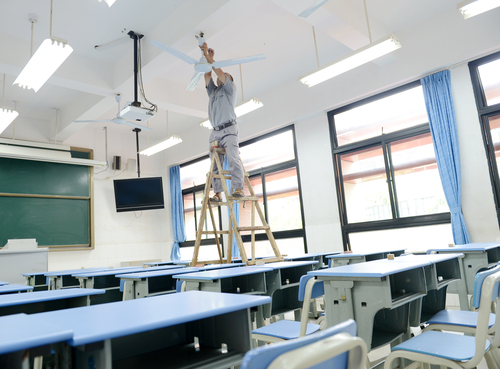When we think of educational institutions, we often think of the students, faculty, and staff who make up these communities. However, behind the scenes, there is a complex network of facilities that play a vital role in creating a positive learning environment.

This is often done through facilities management, which maintains all physical assets such as buildings, grounds, equipment, and utilities. It usually includes everything from ensuring clean and well-maintained classrooms to overseeing energy usage and waste disposal.
However, directing these places can present unique problems. This article will explore some of these challenges and how they can be navigated.
Why Every School Needs an Effective Facilities Management Strategy
Facilities management is vital in academic institutions because it directly impacts the environment for students and the working environment for staff. Running a smooth ship can lead to improved student performance, better attendance rates, higher teacher satisfaction, and compliance with health and safety regulations.
On the other hand, poorly directed organizations can lead to higher teacher turnover and lower academic performance. A lack of proper management can also result in delays, disruptions, or even accidents that could have been prevented.
Common Problems in School Facilities Management
There are a variety of unique issues that institutions face that could affect the overall functionality of the buildings. Some of the everyday struggles include:
- Budget constraints: Institutions often have limited budgets, making it tough to address all up-keep and renovation needs.
- Seasonal maintenance challenges: Managing the building during academic sessions can be tricky since there is little repair time. This results in the need to schedule maintenance during breaks or summer months, which can take time to coordinate.
- Poor air quality: Without proper air circulation and filtration, dust and allergens can accumulate in school buildings, causing health issues for students and staff.
- Signage management: Without clear and accessible signage, it can be difficult for everyone to navigate the school premises. This can also lead to inefficient use of space and overcrowding in certain areas.
It can be overwhelming to deal with these hardships while ensuring that students and staff are not disrupted during the academic year. However, it must be done to provide a safe learning environment.
Strategies for Navigating Facilities Management Issues
To deal with the issues mentioned above, it is crucial to have a comprehensive plan. Here are some tips that can help:
- Regular inspections and preventive maintenance: Consistent inspections can help identify potential problems before they become a larger issue. This can save costs in the long run and ensure that facilities are always in good condition.
- Incorporating sustainability practices: Implementing sustainable practices such as energy conservation, waste reduction, and green materials can benefit the environment and reduce long-term costs.
- Cleaning and sanitizing protocols: Recently, it has become increasingly important to prioritize cleaning and disinfection of all areas. So, having a clear plan for regular deep cleaning can assist in preventing the spread of illnesses.
- Utilization of technology: Leveraging technology can greatly improve processes. For example, using relevant software can help schedule maintenance tasks, track inventory, and deal with work orders.
- Clear communication and collaboration: To be effective requires clear communication and collaboration between all stakeholders, including school administrators, maintenance staff, teachers, and students. Regular meetings can help address problems and allow everyone to implement solutions together.
It is also essential to regularly review and assess the effectiveness of these plans to make any necessary adjustments.
Security and Safety Protocols within Educational Institutions
These institutions also have a responsibility to ensure the safety of students and staff, which involves implementing proper strategies to prevent accidents, injuries, or unauthorized access to school premises. Some key areas that require attention include:
- Emergency exits: These need to be clearly marked, accessible at all times, and regularly checked for functionality.
- Fire safety: Schools should have proper fire extinguishers, alarms, and evacuation plans to prevent and respond to potential fires.
- Crisis management: In the event of a crisis situation, such as natural disasters or violence, schools should have protocols in place to guarantee the security of everyone on campus.
- Security measures: This includes having security personnel on-site, installing surveillance cameras, and conducting regular drills.
It cannot be stressed enough how vital it is to have reliable safety procedures in place. This is also critical for maintaining the reputation and credibility of the organization.
How Facilities and Security Can Work Together for Emergencies
In case of emergencies, facilities management and security teams must work together to ensure the safety of students and staff. This can include evacuation procedures, emergency communication systems, and designated safe zones. They should also regularly conduct drills and safety training exercises to establish a coordinated response.
There are many struggles that come with managing educational institutions, but with adequate planning and collaboration, they can be addressed. So, it is crucial to prioritize both facilities and security management to provide a productive learning environment.
Conclusion
Facilities management is often the invisible but essential force driving public and private school institutions. Without it, students would be left bereft of education in the best-case scenario and unsafe in the worst case. With an efficient facilities management team, we can avoid these scenarios altogether and benefit students and society as a whole.
Miles Oliver is an independent writer with a background in business and a passion for tech, news, and simply helping people live happy and fulfilled lives. He has lived and traveled all over the United States and continues to expand his awareness and experiences. When he is not writing, he is most likely mountain biking or kicking back with a cup of tea.
